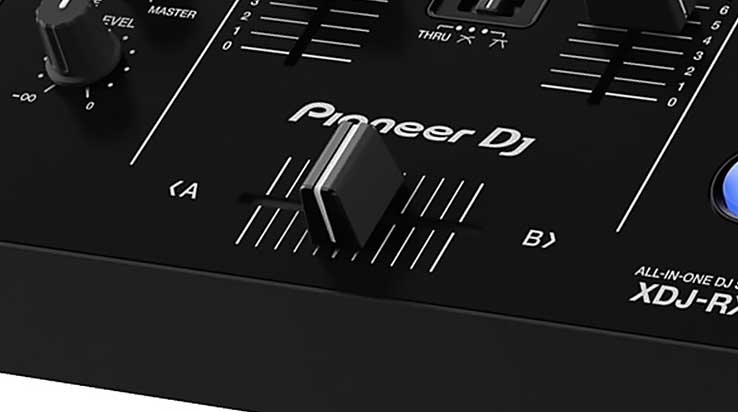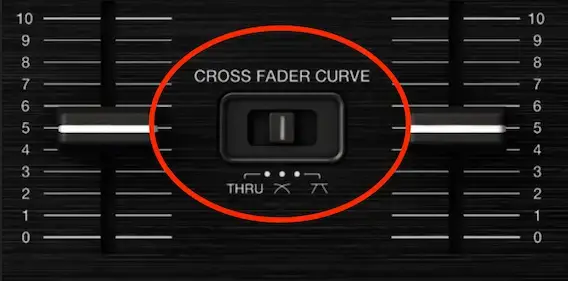What is a crossfader on DJ equipment, what does it do and how do you use it? Here are the quick answers to all your burning questions!
What is a crossfader on a DJ mixer and what does it do?

A crossfader is a part of an audio mixer that allows you to smoothly transition between audio sources playing through different mixer channels. The crossfader is usually placed in a central position between two channels on a DJ mixer. This allows the DJ to for example do a simple AB transition between two tracks by moving the crossfader from one side to the other.
A crossfader is one of the most important parts of a DJ mixer or a DJ controller, and is most commonly used for doing simple track to track transitions and scratching.
When doing a scratch routine, DJs use the crossfader to abruptly cut off the sound from the audio channel on which the scratch sample is played. This, alongside with certain vinyl record / jog wheel platter movements allows for creating many complex rhythmic patterns that are the essence of scratching.
Because the crossfader needs to be moved faster than the regular mixer faders for the DJ to be able to execute all the fast-paced scratching techniques, it will also be naturally more loose than the main audio faders on your equipment. More on that here: Why Is My Crossfader Loose? – DJ Equipment
Did you know? – While the crossfader can certainly be used for track transitions, many DJs (including myself) prefer to simply use the mixer channel faders when transitioning from one track to the other for more precise control. Where you can’t really replace a crossfader though, is when you’re scratching.
What is a crossfader curve?

Crossfader curve is an adjustable characteristic of crossfaders on DJ mixers and controllers that allows DJs to adjust the rate at which one audio signal fades out as another fades in.
The crossfader curve can be often modified using a dedicated curve knob/switch on a mixer or a controller, that allows the DJ to customize the transition shape between the two audio signals. For example, a steeper curve would result in a more abrupt transition, while a shallower curve would create a smoother transition. Crossfader curves are adjustable so that DJs can choose the type of transition they want to create.
Steep crossfader curves are most often used for scratching, while smooth curves are meant to be used for simple track to track transitions. You can learn much more about crossfader curves in our neat resource here.
Did you know? – some DJ mixers feature a so-called “hamster switch”. This switch is used to reverse the crossfader position, so that the left side position of the fader corresponds to the right deck, and vice versa.
Can you replace a broken crossfader?
Changing or replacing a broken or worn out crossfader is possible, albeit only on DJ mixers and DJ controllers that actually allow it by design. The types of DJ hardware with replaceable crossfaders will in most cases have two or more small screws positioned right on, or right next to the crossfader cover plate on the mixer. In other cases, the screws won’t be visible on the chassis and replacing the crossfader will require removing a part or the entirety of the front plate cover.
While the replacement process will differ from device to device, in general it will involve sourcing a new crossfader that is compatible with the unit in question, removing the old fader, screwing in a new one and then optionally re-lubricating the newly mounted part.
The most important things to know here:
- Replacement crossfaders for some devices might actually be pretty hard to come across.
- In cases of some DJ controllers and mixers, attempting to replace the crossfader outside of the official service results in a warranty void.
- Once again: not every DJ mixer and DJ controller supports easy crossfader replacement. In cases of some devices, especially most entry-level DJ controllers, a broken crossfader won’t be easily serviceable.
How do clean mixer faders and your crossfader?

There are many methods to fix up a crossfader that becomes hard to move because of dust or other kinds of small debris getting into the faders mechanism. The easiest ones involve using a simple can of compressed air, the more complex ones – contact cleaner sprays like DeoxIT. Finally sometimes, if a fader cannot be cleaned from the outside, the only option is dissasembly and thorough internal cleanup of the device with optional fader re-lubrication.
If you want to know more about cleaning mixer faders on various types of DJ equipment check out this: How To Clean Audio Faders On A DJ Mixer? (No Disassembly!)

